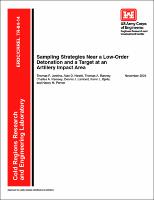Please use this identifier to cite or link to this item:
https://hdl.handle.net/11681/5375| Title: | Sampling strategies near a low-order detonation and a target at an artillery impact area |
| Authors: | Jenkins, Thomas F. Hewitt, Alan D. (Alan Dole) Ranney, Thomas A. Ramsey, Charles A. Lambert, Dennis J. Bjella, Kevin L. Perron, Nancy M. |
| Keywords: | Bombing and gunnery ranges--Testing Explosives, Military Fort Polk (La.) |
| Publisher: | Cold Regions Research and Engineering Laboratory (U.S.) Engineer Research and Development Center (U.S.) |
| Series/Report no.: | ERDC/CRREL ; TR-04-14. |
| Abstract: | Abstract: Field sampling experiments were conducted at the firing range at Fort Polk, Louisiana. The objectives were to determine the spatial distribution and best approach for collecting representative surface soil samples to estimate mean concentrations of residues of high explosives at two types of potential source zones: (1) an area near a low-order [partial] detonation of an 81-mm mortar and (2) an artillery/mortar target. Soil sampling near the low-order detonation revealed the presence of potential “hot spots” and showed that the concentrations of RDX and TNT ranged over five orders of magnitude. The range of concentrations was reduced to a factor of about 60 when randomly collected 25-increment composite samples were collected within this area. The range reduced further to about a factor of three for four simulated (i.e., existing discrete-values) 25-increment systematically derived composite samples. Thus a vast improvement in the repeatability of replicate samples can be achieved using composite sampling approaches. Composite samples collected around a target showed that the distribution of energetic residues was random and overall the concentrations were much lower than around the partially detonated round. |
| Description: | Technical Report |
| URI: | http://hdl.handle.net/11681/5375 |
| Appears in Collections: | Technical Report |
Files in This Item:
| File | Description | Size | Format | |
|---|---|---|---|---|
| CRREL-TR-04-14.pdf | 1.59 MB | Adobe PDF |  View/Open |